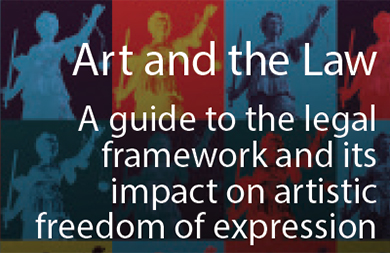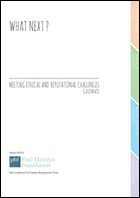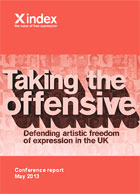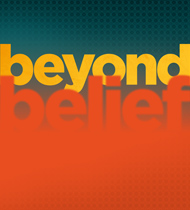A version of this article originally appeared in The Guardian
Police involvement in the cancellation this week of a National Youth Theatre production highlights again the difficult legal challenges for arts organisations putting on contentious work. Can a new set of guidelines help?
By Julia Farrington
7 August 2015
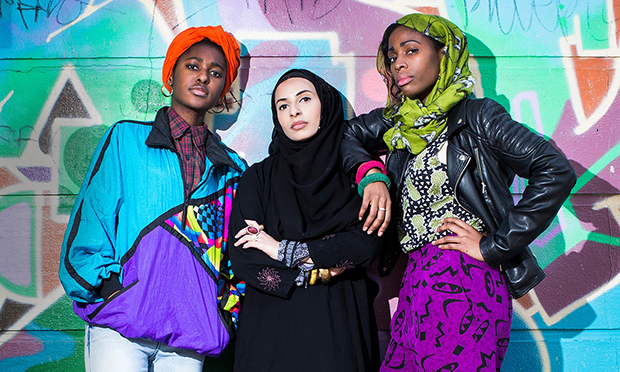
The 112 young cast members were two weeks into rehearsal when the production was cancelled. (Photo: Helen Maybanks / National Youth Theatre)
In September last year, the arts world was blindsided by the closure of white South African artist Brett Bailey’s Exhibit B exhibition at the Barbican. Bailey’s controversial work featured live actors in tableaux mimicking the anthropological exhibits of the 19th century, when real people were exhibited as curiosities for the amusement of Europeans – people such as Saartjie Baartman, the “Hottentot Venus”.
Bailey presents his show as antiracist and anticolonial. This newspaper agreed, giving it five stars during its Edinburgh run, and praising Bailey’s “fearlessly uncompromising” approach. Others took a diametrically opposed view. Sara Myers, a journalist in Birmingham, started Boycott the Human Zoo, an online petition, supported by a broad coalition of campaigners, artists and arts organisations, condemning the work and calling for it to be cancelled. On the opening night in London, protesters gathered to picket the show. Accounts differ as to what happened next, but the evening ended with police advising that Exhibit B be shut down, and not reopened. The Barbican felt they had no alternative but to follow the advice.
The Exhibit B closure may have been unexpected, but it was not unprecedented. Last year in Edinburgh, pro-Palestinian and pro-Israel supporters protested outside The City – a hip-hop musical by Israeli company Incubator that received funding from the Israeli government. There, again, the police advised the venue to cancel the show. And as far back as 2004, the West Midlands police similarly advised Birmingham Rep to cancel Gurpreet Kaur Bhatti’s play Behzti about abuse and corruption in a Gurdwara (Sikh temple), when protesters from the Sikh community, who had demonstrated outside the theatre for several days, tried to break into it. It was Bhatti’s subsequent play, Behud, an imaginative response to the experience of having Behtzi cancelled, that provided the point of departure for an ongoing programme of work looking at constraints on freedom of expression in UK that I started at Index on Censorship.
At the start of that programme, I wrote a case study of the premiere production of Behud at the Belgrade theatre in Coventry called Beyond Belief – theatre, freedom of expression and public order. Given the controversy surrounding Behzti, Behud was treated as a potential public order issue from day one. Importantly, it revealed that there was, and there remains, no specific guidance for policing of artistic freedoms. It also spawned a series of roundtable discussions and a couple of conferences on the status of artistic freedom, the second of which, Taking the offensive at the Southbank Centre in 2013, looked at how lack of clarity around policing roles and the law contributed to growing self-censorship in the cultural sector. Coming out of this conference was a picture of self-censorship as pervasive, complex and troubling, and there was a clear call for guidance to navigate an increasingly volatile cultural landscape. Specifically, many arts professionals who attended the conference were unclear about the role of the police and largely ignorant of the laws that impact on what is sayable in the arts.
This is no surprise – for several reasons. There is no training for arts professionals in art and the law as part of tertiary education. There is also very little in the way of legal precedent to guide arts organisations. And, of course, freedom of expression is innately complex. The right to it includes the right to shock, disgust and offend. But it is also not perceived as an absolute right, as demonstrated in the long list of qualifications in Article 10 of the European convention on human rights where freedom of expression is qualified by concerns including national security, the prevention of disorder and the “protection of health or morals”. It is therefore unsurprising that arts organisations can be unsure about how best to defend their right to free expression.
Tamsin Allen, senior partner at law firm Bindmans, and I decided to do something to help and have produced a series of information packs for arts organisations that introduce the law in a way that is relevant and tailored to their needs. The guides contextualise and explain qualifications to free expression, how they are represented in our legislation and what they mean for artists and arts bodies.
Choosing five areas of law that address these protected areas – legislation covering child protection, counter terrorism, public order, obscenity and race and religion – the lawyers explain the offences, and the roles and responsibilities of police and prosecuting services, as well as those of artists and arts bodies. However, it is the pack on public order that is probably most relevant to the arts sector, because it is far more likely that a public order problem arises because of the reactions of third parties to the work of art. This reflects how the art we see is much more subject to social rather than legal controls, and that is where the police come in, to arbitrate over the public space where some deep-seated social conflicts are acted out.
The packs explain that the police have a duty to support freedom of expression and to protect other rights, to prevent crime and to keep the peace. They summarise relevant legislation, explaining the qualified nature of the right to freedom of expression due to the offences in each area of law, and give guidance how best to prepare if you think the work could be contested. The guidance encourages arts organisations to be prepared to defend work they believe in, advises them on when and how to involve the police and on how to anticipate potential problems, guided as much by good practice and common sense as a detailed understanding of the law, most of which most organisations and artists will be doing anyway.
The packs are not a substitute for legal advice and provide links to law firms willing to give advice on this area. It includes a series of case studies that consider recent examples of police and/or lawyers having been involved in an artistic event, which look at things that worked well for freedom of expression and things that didn’t.
However, we have a problem. The heckler’s veto is working. When faced with a noisy demonstration, the police have shown that they will all too often take the path of least resistance and advise closure of whatever is provoking the protest. Arts organisations may have prepared well, and yet still find themselves facing the closure of a piece of work. This sends out a disturbing message to artists and arts bodies – that the right to protest is trumping the right to freedom of artistic expression. As things stand, in the trigger-happy age of social media where calls for work that offends to be shut down are easily made and quickly amplified, the arts cannot count on police protection to manage both the right to protest and to artistic expression. The police did a risk assessment on Behud and asked for £10,000 a night to provide adequate protection. Hamish Glen, artistic director of the Belgrade, explained that this was a fiscal impossibility – so the police offered to halve it, eventually waiving the fee altogether once Glen pointed out that even half was prohibitive and represented de facto censorship. But it exposed the fact that there is no guidance around the policing of artistic expression as a core duty, leaving it vulnerable. The fees were calculated based on how the police charge for attending football matches and music festivals. I have not heard of an arts venue being asked to pay for policing before.
In an ideal world we would have access to both the artwork and the protest it provokes. This is when art really works for society, when it encourages debate, inspires counterspeech; art coming from all perspectives and all voices in society, in particular those who are currently shamingly mis- or underrepresented in contemporary culture.
If we are to create the space where artists are free to take on the more complex issues in society, that may be disturbing, divisive, shocking or offensive, then we need to look again at the role of the police in helping to manage the public space in which different views meet. These may in fact be the same issues that the police are called on to manage through community relations policing, and this only adds to the complexity of their role – they probably would prefer it if artists didn’t rock the boat. And they can point to being resource-strapped and under pressure to fight crime.
The situation raises a series of difficult and important questions about policing, art and offence and requires high-level discussion, involving the police of course, about how best to defend the right to free expression. That work needs to start now.
• Julia Farrington is associate arts producer for Index on Censorship, a Vivarta associate and head of campaigns for Belarus Free theatre.
A version of this article originally appeared in The Guardian on 7 August 2015

